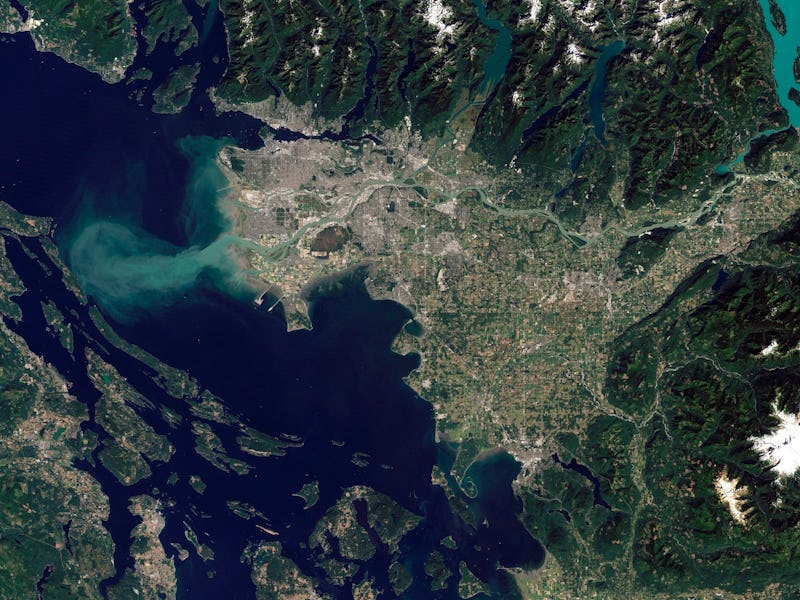The Future of Vancouver: Trains Trump Driverless Cars When Land Is Limited
Will the "Vancouverism" school of urban design and planning survive?

“It was Americans who invented the term Vancouverism,” Trevor Boddy reminds me, referencing the fact that there is nothing distinctly Canadian about the country’s 8th(ish) biggest city. The city’s planners did not really intend to distinguish their work so much as to create something effectively derivative. But they succeeded beyond the wildest dreams they didn’t really have and Vancouver began evolving into a strange urban design island.
But what exactly is Vancouverism?
“This has always been a place of housing innovation,” Boddy, an architect and critic, explains. “Vancouverism in its various form today is just continuum of responses to limited land, and the need to go up and be more efficient.” What makes the city unique is its reaction to its unique location. It sits near the U.S. border, squeezed between mountains and the Pacific Ocean. Land prices have always been high because it’s beautiful and there really isn’t that much land people can live on without investing heavily in hiking boots (probably Dayton boots, this being Canada).
Unfortunately, because making the most of limited space was always the number one priority for the people running the city, transportation was not. Now, Vancouver is a dense city “in a position to be a transit-led city,” but badly in need of an upgrade. But it’s not that simple. It never is. Here’s the catch: Twenty years ago, the city made the choice to rezone much of the downtown into “housing-optional”. Developers make more money on housing than they do businesses. Suddenly, the city center became overwhelmingly residential.
Nowadays, downtown is pretty much developed out. So are the older industrial sites. The challenge is finding places where newer businesses can insert themselves into the city, rather than be forced to situate themselves out in the suburbs in places that are beyond public transit access, is significant. “That’s just crazy,” says Boddy. “Our pattern of job location has not followed transit as much as it should have.”
A train of Vancouver's Skytrain (Millenium Line) at Rupert station
Boddy doesn’t necessarily think bigger infrastructure projects are the solution. Instead he points to a few ideas that instead work to create fresh trends in zoning and housing.
For starters, he’s enthusiastic about laneway houses. These a homes that are built into pre-existing lots that open into the back lane. “It’s a painless way to get density,” says Boddy, and they’ve been springing up rapidly in Vancouver over the last few years, now that new laws make it easier to build such forms of housing. Though small, they draw upon existing forms of infrastructure push forward compact efficiency.
Other solutions, Boddy says, are building houses on arterial roads. Changes to zoning laws are making it easier for developers to build homes sitting right alongside commercial thoroughfares, where shops can remain on the first floor, and you can provide five stories of housing above. “That’s another painless solution,” he says. “It’s keeping retail alive as well as providing homes for people along transit lines.” Boddy wishes that development would invest more in townhouse construction, but residents have been pushing back against such designs.
In general, downtown is beginning to pivot once-more into a place for offices and businesses. But the balance is still askew. The old rail system, built radially to connect surrounding areas to downtown, has not changed, even though the jobs are all away from downtown.
Boddy isn’t quite sure what the city is going to look like in order to better connect the housing centers to jobs, but he has some ideas. He’s skeptical about exactly how much impact the driverless car will have on transportation — with good reason — and doesn’t want to rely heavily on technologies that haven’t yet proven effective. Instead, he wants to see the city proactively pinch off the housing boom, and incentivize business and commercial development.
But there are few spots left. Vancouver cannot accommodate much more of, well, anything. One of the few places, suggests Boddy, is to increase density around train stations, giving commuters quick access to points they can jump off it to get around. The River Green spearheaded Aspic Developments in the suburb of Richmond makes of use of slab walks by building townhouses at the base and constructing decks on top of them. “It’s an unusual high-density suburban development,” says Boddy, that emphasizes walkability to nearby spaces. He thinks it’s a sign of what future development around Vancouver will trends towards. “If we could find places for projects like River Green in other North American suburbs, I think we’d be way ahead of the game.”
As the city gets bigger, Vancouver is unlikely to go the way of New York City and other urban communities and embrace a maximal form of public transit. Vancouverism will live on because the city continues to think about its needs in innovative ways.